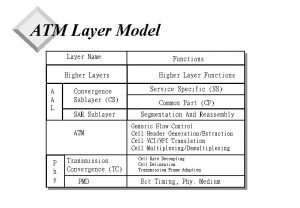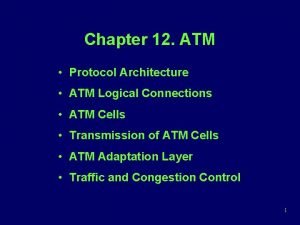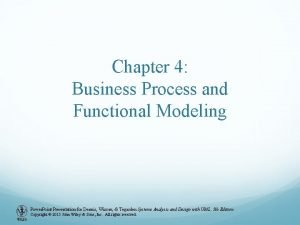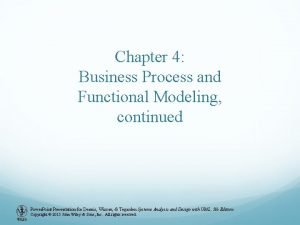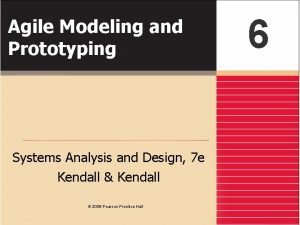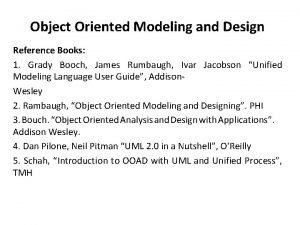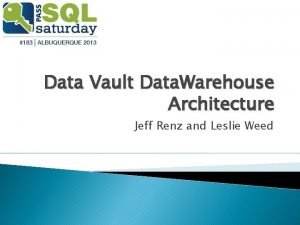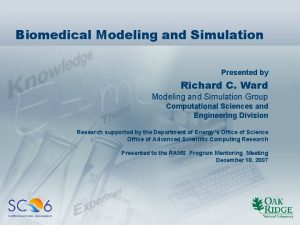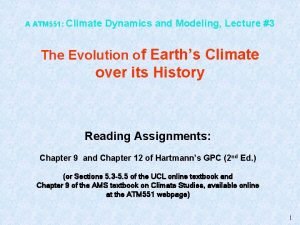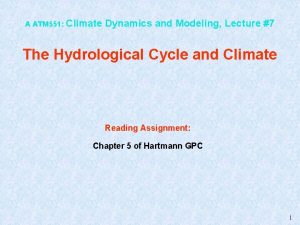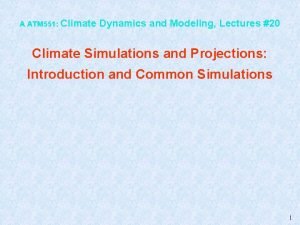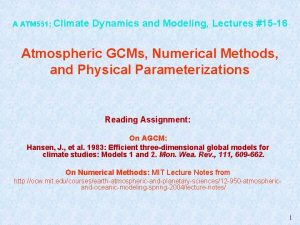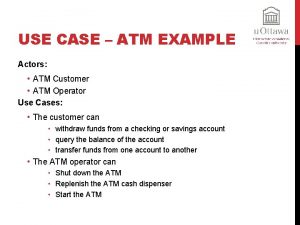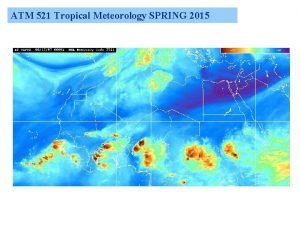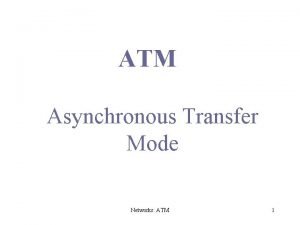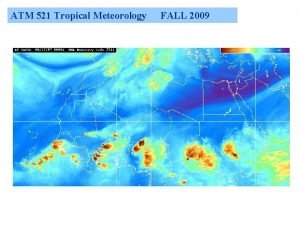A ATM 551 Climate Dynamics and Modeling Lecture




















































- Slides: 52

A ATM 551: Climate Dynamics and Modeling Lecture #1: The Earth Climate System Instructor: Prof. Aiguo Dai Email: adai@albany. edu Department of Atmospheric and Environmental Sci. University at Albany, NY Spring, 2020 Class room: BI 152 Class time: Fri: 2: 45 -5: 35 PM Office hours: Tue. Wed: 10 -11 AM Course web site: http: //www. atmos. albany. edu/facstaff/adai/ATM 551/ ( id = atm 551 password=dai 551 ) 1

Design of the Course (1/3) • Goal: To discuss physical processes that control Earth’s climate and how they are represented in numerical climate models. • Prerequisites: You are assumed to have taken introductory courses in atmospheric science (e. g. , Thermodynamics, Radiation, Dynamic Met. ). • First Half (14 lectures): Climate Dynamics Part 1 – Overview of Earth’s Climate (3 lectures) Lecture 1: The Earth Climate System (1/24) Lecture 2: Characteristics of Earth’s Current Climate (1/24) Lecture 3: Evolution of Earth’s Climate over its History (1/31) Part 2 - Processes Controlling the Climate (11 lectures) Lecture 4: Climate Modes of Variability (1/31) Lecture 5: The Global Energy Balance & Greenhouse Effect (2/7) Lecture 6: Surface Energy Balance (2/7) Lecture 7: The Hydrologic Cycle and Climate (2/14) Lecture 8: Atmospheric Circulation and Climate (2/14, 2/21) 2

Design of the Course (2/3) Part 2 - Processes Controlling the Climate (cont’d) Lecture 9: Ocean Circulation and Climate (2/21) Lecture 10: Water Vapor, Clouds, and Aerosols (2/28) Lecture 11: Atmospheric Convection (2/28) Lecture 12: Air-sea & Land-Atmosphere Interactions (3/6) Lecture 13: Mid-term review lecture: 3/6. Mid-term Exam: March 13. Spring break: 3/14 -3/20 • Second Half (12 lectures): Climate Modeling Part 3 – Description of Climate Models (6 lectures): including equations. Lecture 14: Introduction to Climate Modeling (3/27) Lecture 15 -16: Atmospheric General Circulation Models (AGCMs) (3/27, 4/3) Lecture 17: Ocean General Circulation Models (OGCMs) (4/3) 3

Design of the Course (3/3) Part 3 – Description of Climate Models (cont’d) Lecture 18: Land Surface Models (4/10) Lecture 19: Sea-ice and Glacier Models (4/10) Part 4 – Climate Simulation and Projection (5 lectures) Lecture 20: Introduction + Common Climate Simulations (4/17) Lecture 21: Climate Variability, Forcing, Response, & Feedbacks (4/17, 4/24) Lecture 22: Historical Climate Simulations (4/24) Lecture 23: Climate Prediction and Projection – CMIP (5/1) May 1: Student Presentations (~20 min each student) May 13: Research term paper due date The grades of your term paper (60% weight) and your oral presentation (40%) will serve as the grade for your final exam. 4

Course Assessment • • Homework : Mid-term Exam (closed-book): Final Exam: (Oral presentation + term Paper) Attendance and Class Discussions: 30% 30% 10% • Homework Assignments: - Usually assigned after each class and due next week in hard copies. - Homework may include reading assignments. - Questions will be mostly descriptive. For example: What are the major components of the Earth Climate System? What are the key roles of water in the Earth Climate System? - Late homework will not be graded, except for special cases! • Mid-term exam: - To test your understanding of the topics discussed in class. Mostly descriptive questions. 5

Textbooks and Reading Materials Main Textbooks: Hartmann, D. L. , 2016: Global Physical Climatology. 2 nd ed. , Elsevier, 485 pp. Neelin, J. D. , 2011: Climate Change and Climate Modeling. Cambridge Univ. Press, 282 pp. Goosse, H. , P. Y. Barriat, W. Lefebvre, M. F. Loutre, and V. Zunz, 2012: Introduction to Climate Dynamics and Climate Modeling. Online textbook available at http: //www. climate. be/textbook. Additional Reading: Pierrehumbert, R. T. , 2010: Principles of Planetary Climate. Cambridge University Press, 652 pp. Washington, W. M. and C. L. Parkinson 2005: An Introduction to Three-Dimensional Climate Modeling. 2 nd edition, University Science Books, Sausalito, CA, 353 pp. Moran, J. M. , 2010: Climate Studies: Introduction to Climate Science. Amer. Met. Soc. , 525 pp. (AMS Textbook, pdf files available at my course webpage)

Second Edition (2016, Elsevier) Hardcopy (8/2015, Cambridge Univ. Pres

2011

ATM 551 Webpage • http: //www. atmos. albany. edu/facstaff/adai/ATM 551/ ( id = atm 551 password = dai 551 ) • My ppt slides will be available at this website about 24 hours before each class. • Other electronic materials will also be posted at this website. • Homework questions will also be posted at the website, often included in one ppt slide of the last lecture. • The course will cover very broad areas; you may need to read the chapters in the textbooks to gain deeper understanding on some of the areas (e. g. , radiative transfer, cloud microphysics, PBL, etc. ). 9

Lecture Format • Each lecture will be 80 min. , with 5 -10 min. break at the half (I may show a video clip during the break); two lectures on Fridays. • Lectures will be given with Power. Point slides, which will be available online about 24 hrs before the class; • You’re expected study all the ppt slides before and after each class; • I will discuss only some of the key slides and ask you questions about the content of the other slides; • You’re encouraged to take notes of the key points discussed during the class, but no need to copy the slides; • Discussions and questions will be part of the lecture, and • All students are encouraged to ask and answer questions. This will be part of the evaluation! 10

Today’s Topic: An Overview of the Climate System • Difference between Climate and Weather • What is the Climate System? • The Main Components and their Roles - The Atmosphere - The Oceans - Land the Biosphere - The Cryosphere 11

Weather vs. Climate 1. Weather refers to - The state of the atmosphere (mainly the troposphere) at a given time. - Short-term (hour to week) variations in temperature, precipitation, circulation and other atmospheric fields. 2. Climate refers to - The mean state near the surface and in the atmosphere averaged over several decades or longer (typically 30 years) - Often characterized by mean T, P, sunshine and other near-surface fields - Global climate change can affect local mean climate including extreme weather, but individual events (such as a cold spell or a heat wave) result mostly from random weather variations. 3. Predictability of Weather and Climate: - Weather becomes unpredictable after 2 weeks due to the chaotic nature of atmospheric circulation and sensitivity to errors in initial conditions (explain it). - Monthly-seasonal mean states (e. g. , associated with ENSO) may be predicted several months ahead (why? ) - Some decadal climate variations may be predicted many years ahead (why? ) - Greenhouse-gas forced climate changes can be predicted decades into the future given GHG emissions scenarios (why? ). - Why is there the difference between weather and climate predictability? 12

Albany Daily Tmax Climate: Mean Annual Cycle Which one is easier to predict for the same lead time? Weather: Daily Variations

The Earth Climate System The Sun, volcanoes, and human activities are considered external to the Climate System Weather occurs mostly in the troposphere!

The Earth Climate System • Major Components: - The Atmosphere (the troposphere, h< 12 km and the stratosphere, h= 1250 km), time scales: hours to 10 days - The Oceans: depth up to 4000 -5000 m. Time scales: seasons to 1000 yrs. - Land: terrestrial biosphere, soils. Time scales: hours to decades - The cryosphere: polar ice sheets, mountain glaciers, snowpack, sea-ice. Time scales: seasons to 1000 yrs. • Major Interactions: - Air – sea interactions (e. g. , El Niño, air-sea energy and water fluxes) - Land-atmosphere interactions (e. g. , morning fog, surface fluxes over land) • Major Cycles: - The water cycle - The energy cycle - The carbon cycle and other biogeochemical cycles (e. g. , Sulfur, Nitrogen cycles) • Natural and Anthropogenic Forcing: - Changes in solar irradiance, volcanic eruptions, CO 2 changes on geological times - CO 2 emissions from fossil-fuel burning, human-induced land cover changes, etc.

Atmospheric Vertical Profiles Hydrostatic Equilibrium: dp g dz where H is a scale height H=7 to 8 km Lapse Rate: Global mean 6. 5 K/km in the Troposphere Where most weather and climate processes occur 17

Atmospheric Circulation 18

Key Roles of the Atmosphere • It affects the amount of sunlight reaches the surface. • It determines the amount of outgoing infrared radiation into the space. • It absorbs harmful UV radiation and protects life on Earth. • It interacts with the oceans and land, and helps redistribute energy and water on Earth. • It largely controls the weather and climate on Earth!

World’s Oceans Seawater Composition: On average, seawater has a salinity of about 3. 5%. This means that every kilogram of seawater has approximately 35 grams of dissolved salts (predominantly sodium (Na+) and chloride (Cl−) ions). Average density at the surface is 1. 025 g/ml. Seawater is denser than both fresh water and pure water. Sea Surface Salinity Distribution: Salinity (salt content) and temperature determines seawater density, which differs among different types of ocean water PSU = Practical Salinity Units, A PSU of 35 means 3. 5% salt. 20

Ocean Temperature Mixed Layer What determines the SST patterns? SST provides the lower boundary condition for the atmosp 21

Seasonal Variations in Mixed Layer Depth (at a northern mid-latitude) 22

Ocean Overturning Circulation 23

Key Roles of the Oceans • They absorb and store large amount of solar radiation. • They provide water vapor and heat for the atmosphere. • They help re-distribute energy and water on Earth. • Their long memory induces decadal climate variations. • They affect carbon and other biogeochemical cycles.

Seasonal Cycle in Land Cover as Measured by Satellite NDVI 25

Natural Land Cover Types

Surface Albedo (Ratio of reflected to incoming solar radiation)

Typical Surface Albedo Values

Evapotranspiration over Land Evaporation Wang and Dickinson (2012) 30

Key Roles of the Continents • Land cover types determine how much sunlight is absorbed and how much is reflected. • Land exchanges water, energy and carbon with the atmosphere, thus affecting atmospheric water and energy balance and CO 2 content. • Terrain over land also affects atmospheric circulation and precipitation. • Soil moisture has a memory of months that can induce seasonal to inter-annual variations in climate.

The Cryosphere • The frozen places on Earth, including snow cover, river and lake ice, sea ice, glaciers and ice caps, ice shelves and ice sheets, and frozen ground. Time Scales

Alaska Antarctica

Cryosphere Components 106 km 2 106 km 3

Sea Ice • Sea ice covers both the N. and S. Hemisphere polar regions • Varies seasonally: S. H. : A minimum of 3 -4 million km² in February to a maximum of 17 -20 million km² in September, 1 -2 m thick N. H. : A minimum of 7 -9 million km² in September to a maximum of 14 -16 million km² in March. 2 -4 m thick • Satellite passive microwave obs began in the late 1970 s. • Main data source: National Snow and Ice Data Center (NSIDC) in Boulder, CO (http: //nsidc. org/cryosphere/sotc/sea_ice. html) 35

Map of the Arctic Ocean

37 http: //nsidc. org/arcticseaicenews/category/daily-image/

Arctic Antarctic

Arctic Sea-ice Annual Cycle

Worby et al. 2008 Antarctic Sea-ice annual-mean thickness (m) http: //www. esa. int/esa. CP/SEMAAW 0 T 1 PG_index_0. ht ml

Arctic Sea-ice Loss Sept Area Coverage Magenta line = 1979 -2000 mean of 8. 7 million km 2 Source: NSIDC Lowest on Record 2012 2016

http: //nsidc. org/arcticseaicenews/2019/10/falling-up/ 43

Arctic Sea-ice Loss is Largest in Fall.

Arctic Sea-ice Extent: Historical Perspective Kinnard et. al 2011, Nature: based on proxy data from ice-cores, tree-ring, lake sediments, documentary, ocean cores around the Arctic.

Antarctic vs. Arctic Sea-ice Extent Trends Source: NSIDC based on satellite microwave obs.

Some Basics about Glaciers • A glacier is a large persistent body of ice that forms where accumulation of snow exceeds its ablation (net melting). • Glacier types: - alpine glacier or mountain glacier, called an ice cap if over a whole mountain - ice sheet or continental glacier: Greenland Antarctica • Glaciers cover 10% of global land areas currently, about 1/3 of global land during the LGM about 18 ka ago when sea level was 120 m lower. • Glaciers store about 69% of Earth’s freshwater. They would raise the sea level by 70 m if they all melted. • About 1/3 of world’s population depends on glacial water. • Most glaciers move downhill and change on time scales of 10 -1000 years • Glacier dynamics is complicated and has not yet been included in most climate models. 47

Mass Balance of Glaciers

Greenland Ice Sheet Retreat Source: http: //www. eea. europa. eu/data-and-maps/figures/melting-area-197920132008 -and-

Antarctic Ice Shelves 0 o Indian c. P en ins ula Bellingshausen Sea 90 o. W Amundsen Sea So u th Ross Sea Pa cif ic Oc ea n 180 o Ocean cti East Antarctica Weddell Sea tar West Antarctica An South Atlantic Ocean 90 o. E

Antarctic Ice Sheet Mass Change

Key Roles of the Cryosphere • It affects the height of global-mean sea level. • Ice and snow reflect more sunlight to space than other surfaces, thus affecting Earth’s energy balance. • Snowpack and mountain glaciers provide freshwater for 1/3 of world’s population. • It interacts with the atmosphere and oceans, contributing to the glacier-interglacier cycles in Earth’s history.

Key points of Today’s Lecture • Overview of the course: - Course outline - Homework sets - Mid-term and final exam dates • The Earth Climate System: - Major components: The atmosphere, oceans, land, and the cryosphere - Their basic features - Their main roles in the climate system

Homework Assignments: Read Chapter 1 of UCL online textbook (pdf file available at http: //www. atmos. albany. edu/facstaff/adai/ATM 551/UCL-Clim. Dyn/ - - Review my ppt slides, and think of the following questions: 1. What are the main differences between weather and climate? 2. Why should one trust model simulations of the climate decades into the future when we cannot predict the weather beyond 1 -2 weeks? 3. In your own words, describe the main components of the climate system and their key roles for Earth’s climate. 4. What are the typical value range and spatial patterns of the sea surface temperature (SST) and sea surface salinity (SSS) in world’s oceans? What determine these spatial variations in SST and SSS? (You do not need to turn in answers to these questions. )

Next Lecture: Characteristics of the Current Climate Thank You!
 Erickson nursing theory
Erickson nursing theory Dimensional modeling vs relational modeling
Dimensional modeling vs relational modeling Power system dynamics and stability lecture notes
Power system dynamics and stability lecture notes Power system dynamics and stability lecture notes
Power system dynamics and stability lecture notes Climate change 2014 mitigation of climate change
Climate change 2014 mitigation of climate change 01:640:244 lecture notes - lecture 15: plat, idah, farad
01:640:244 lecture notes - lecture 15: plat, idah, farad 18 446 744 073 709 551 615
18 446 744 073 709 551 615 Tenho ouvido de uma terra linda encantada
Tenho ouvido de uma terra linda encantada Ece 551
Ece 551 452 nin en yakın yüzlüğü
452 nin en yakın yüzlüğü Akpc 551
Akpc 551 I 551 number
I 551 number Csci-b 551 elements of artificial intelligence
Csci-b 551 elements of artificial intelligence Cs 551
Cs 551 Ece 551
Ece 551 Number 551
Number 551 Cs 551
Cs 551 Four-model approach
Four-model approach Linear quadratic function
Linear quadratic function Typical process description tools include
Typical process description tools include Atm vs frame relay vs mpls
Atm vs frame relay vs mpls Name the atm layers and their functions
Name the atm layers and their functions Pseudocode for baking a cake
Pseudocode for baking a cake Frame relay and atm
Frame relay and atm Atm protocol architecture and logical connection
Atm protocol architecture and logical connection Simulation kelton
Simulation kelton Sequential decision analytics and modeling
Sequential decision analytics and modeling Log to exponential form
Log to exponential form Process modeling in system analysis and design
Process modeling in system analysis and design Requirements modeling in system analysis and design
Requirements modeling in system analysis and design Business process and functional modeling
Business process and functional modeling Business process and functional modeling
Business process and functional modeling Modeling and imitation training aba
Modeling and imitation training aba Jelaskan perbedaan imitasi dan
Jelaskan perbedaan imitasi dan Algebra 1 bootcamp functions and modeling answer key
Algebra 1 bootcamp functions and modeling answer key Algebra 1 bootcamp algebra and modeling
Algebra 1 bootcamp algebra and modeling Algebra 1 boot camp
Algebra 1 boot camp Patched up prototype
Patched up prototype Additive and subtractive modeling
Additive and subtractive modeling Patched up prototype
Patched up prototype Jackie buys 3 hot dogs and 1 pretzel
Jackie buys 3 hot dogs and 1 pretzel 2019 algebra 1 bootcamp answers
2019 algebra 1 bootcamp answers Object oriented modeling and design books
Object oriented modeling and design books Pharmaceutical simulation and modeling
Pharmaceutical simulation and modeling Introduction to modeling and simulation
Introduction to modeling and simulation Jeff renz
Jeff renz Mathematical modeling and engineering problem solving
Mathematical modeling and engineering problem solving Biomedical modeling and simulation
Biomedical modeling and simulation Device modeling for analog and rf cmos circuit design
Device modeling for analog and rf cmos circuit design What is the primary goal in agile modeling
What is the primary goal in agile modeling Solid
Solid Introduction to modeling and simulation
Introduction to modeling and simulation Computational engineering and physical modeling
Computational engineering and physical modeling





















